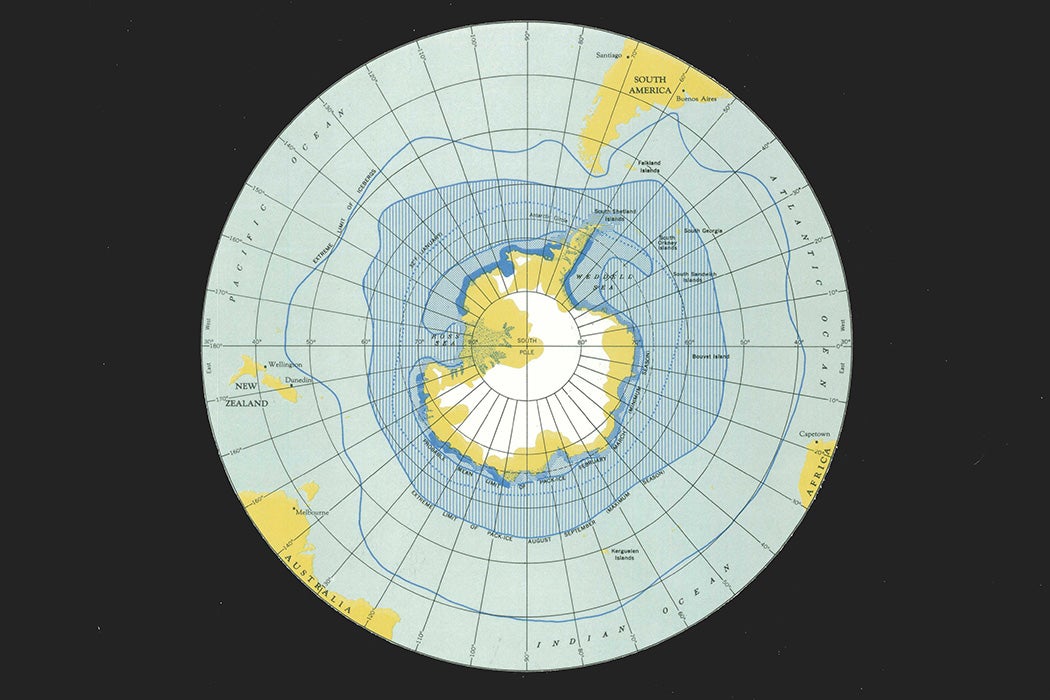On Christmas Eve in 1959, a plane crashed in Antarctica. The pilot cut power, thinking that he was close to landing, but the plane stalled out and slammed into the ground. The pilot survived, but other similar accidents were fatal. An investigation revealed a problem with their instruments—and directly led to the mapping of subglacial Antarctica.
Historian Simone Turchetti and his collaborators explain how incidental discoveries and international collaboration allowed scientists to peer under the Antarctic ice in the 1960s and 1970s. They used airborne laboratories to reveal the landscapes hidden beneath the Antarctic glaciers.
It began with a US Army Signals Corps investigation of a series of crashes which had resulted in nineteen deaths in Antarctica. The culprit was faulty readings from altimeters, which increasingly relied on radar. Measuring the time it took for radio signals to hit the ground and bounce back to the plane provided accurate estimates of altitude—but over glaciers, these estimates proved unreliable.
Engineers figured out that radio waves with certain frequencies simply pass through ice. Pilots were sometimes getting reads of their altitude, not above the ice, but above the ground beneath the ice. It occurred to Army engineer Amory Waite that you could use this to deliberately take such measurements, and he began work on a modified radar altimeter.
Meanwhile, scientists in Antarctica encountered “mysterious interfering signals” while studying aurorae with radar instruments. British physicist Stanley Evans joined up with physicists at the Scott Polar Research Institute (SPRI) to find the source of the signals.
They found that radio signals bounced off the bottom of sea ice and back into the ionosphere, creating interference. Evans and the others realized that this could be used for ice-sounding (finding ice depth) and received funding for a device from the Royal Society in 1962.
The timing was perfect—it was the Cold War, and there was an appetite for big scientific projects. Organizations like the Scientific Committee on Antarctic Research (SCAR), founded in 1958, facilitated collaboration between scientists and engineers across the world. In 1963, British and US glaciologists tested both Waite’s and Evans’s devices in Greenland. They demonstrated the viability of radio echo-sounding (RES), and engineers began refining the technology.
Later in the ’60s, a full-scale mapping project came together with the support of the NSF, SPRI, and the Technical University of Denmark. Their project eventually became part of a larger international effort to explore the glaciers of Antarctica beginning in 1969.
Weekly Newsletter
They built the first of their airborne laboratories in a Lockheed C121 Super Constellation, equipped with RES devices and other scientific instruments. They used oscilloscopes and photography to visualize the data they collected. Later missions used Lockheed C130s, and between 1967 and 1979, planes criss-crossed Antarctica taking measurements, slowly revealing the topography of the continent.
Turchetti et al. believe this episode exemplifies “big science” in the Cold War era. It also shows developments in remote sensing. Similar technologies and techniques are now used on satellites orbiting Earth and other planets and moons across the solar system.
Teaching Tips
- G. De Q. Robin, S. Evans, and J. T. Bailey explain radio echo-sounding in ice sheets (1969)
- Vivian Fuchs, C. Swithinbank, E. Lintz Christensen, P. G. Mott, S. Evans, P. Gudmandsen, and G. de Q. Robin discuss the then-current state of glacier sounding (1969)
- G. De Q. Robin, D. J. Drewry, and D. T. Meldrum report on the results of international efforts to map the ice sheet and bedrock (1977)
- John C. Behrendt, David J. Drewry, Edward Jankowski, and Muriel S. Grim translate the ice-sounding results from the 1978 survey of the Dufek Intrusion, Antarctica (1980)
Support JSTOR Daily! Join our membership program on Patreon today.







